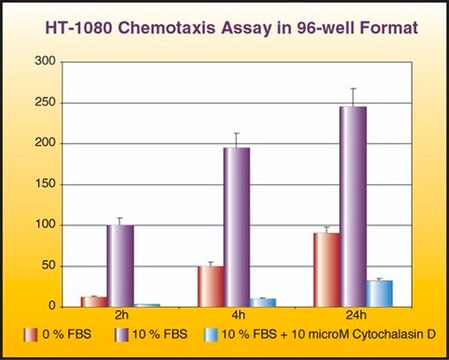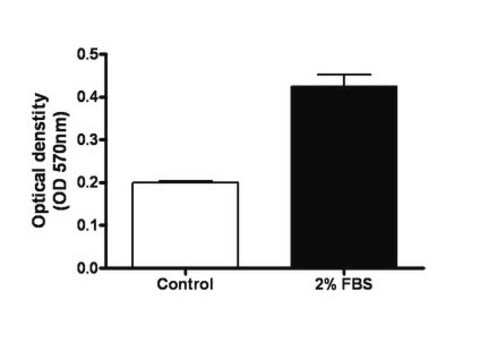ECM545
ECM Cell Adhesion Array Kit, fluorometric
The ECM Cell Adhesion Array kit is useful for assessing specific cell surface integrins, monitoring in vitro cell differentiation, or screening potential cell adhesion promoters/inhibitors.
Faça loginpara ver os preços organizacionais e de contrato
About This Item
Código UNSPSC:
12352207
eCl@ss:
32161000
Produtos recomendados
Nível de qualidade
reatividade de espécies
human
fabricante/nome comercial
Chemicon®
técnica(s)
cell based assay: suitable
método de detecção
fluorometric
Condições de expedição
wet ice
Descrição geral
Introduction:
Cell adhesion plays a major role in cellular communication and regulation, and is of fundamental importance in the development and maintenance of tissues. Scientists are continually examining the adhesion, migration, and invasion of many diverse cell types on various extracellular matrix (ECM) component proteins. The CHEMICON® ECM Cell Adhesion Array Kit (Fluorometric) provides an ECM Array microtiter plate with a homogenous fluorescence detection format, allowing for large-scale screening and quantitative comparison of multiple samples/cell lines. The kit is designed as a rapid (1-2 hours), cost effective, efficient method for characterization of cell adhesion.
In addition, Chemicon continues to provide numerous migration, invasion, and adhesion products including:
· Alpha Integrin-Mediated Cell Adhesion Array Kit (Colorimetric) (ECM530)
· Beta Integrin-Mediated Cell Adhesion Array Kit (Colorimetric) (ECM531)
· Alpha/Beta Integrin-Mediated Cell Adhesion Array Combo Kit (Colorimetric) (ECM532)
· Alpha Integrin-Mediated Cell Adhesion Array Kit (Fluorometric) (ECM533)
· Beta Integrin-Mediated Cell Adhesion Array Kit (Fluorometric) (ECM534)
· Alpha/Beta Integrin-Mediated Cell Adhesion Array Combo Kit (Fluorometric) (ECM535)
· ECM Cell Adhesion Array Kit (Colorimetric) (ECM540)
· QCM 8μm 96-well Chemotaxis Cell Migration Assay (ECM510)
· QCM 5μm 96-well Chemotaxis Cell Migration Assay (ECM512)
· QCM 3μm 96-well Chemotaxis Cell Migration Assay (ECM515)
· QCM 96-well Cell Invasion Assay (ECM555)
· QCM 96-well Collagen-Based Cell Invasion Assay (ECM 556)
· 24-well Insert Cell Migration and Invasion assay systems
· CytoMatrix Cell Adhesion strips (ECM protein coated)
· QuantiMatrix ECM protein ELISA kits
Test Principle:
The CHEMICON ECM Cell Adhesion Array kit utilizes a homogenous fluorescence detection format, allowing large-scale screening and quantitative comparison of multiple samples. Each kit contains a 96-well, microtiter plate consisting of 12 X 8-well removable strips. Each well within a strip (7 wells total) is pre-coated with a different ECM protein (see table below) along with one BSA-coated well (negative control). Experimental cells are seeded onto the coated substrates, where adherent cells are captured. Subsequently, unbound cells are washed away, and the adherent cells are lysed and detected by the patented CyQuant GR dye (Molecular Probes) (1-2). This green-fluorescent dye exhibits strong fluorescence enhancement when bound to cellular nucleic acids (3). Relative cell attachment is determined using a fluorescence plate reader.
Additional information about the ECM components provided in the kit:
Cell adhesion plays a major role in cellular communication and regulation, and is of fundamental importance in the development and maintenance of tissues. Scientists are continually examining the adhesion, migration, and invasion of many diverse cell types on various extracellular matrix (ECM) component proteins. The CHEMICON® ECM Cell Adhesion Array Kit (Fluorometric) provides an ECM Array microtiter plate with a homogenous fluorescence detection format, allowing for large-scale screening and quantitative comparison of multiple samples/cell lines. The kit is designed as a rapid (1-2 hours), cost effective, efficient method for characterization of cell adhesion.
In addition, Chemicon continues to provide numerous migration, invasion, and adhesion products including:
· Alpha Integrin-Mediated Cell Adhesion Array Kit (Colorimetric) (ECM530)
· Beta Integrin-Mediated Cell Adhesion Array Kit (Colorimetric) (ECM531)
· Alpha/Beta Integrin-Mediated Cell Adhesion Array Combo Kit (Colorimetric) (ECM532)
· Alpha Integrin-Mediated Cell Adhesion Array Kit (Fluorometric) (ECM533)
· Beta Integrin-Mediated Cell Adhesion Array Kit (Fluorometric) (ECM534)
· Alpha/Beta Integrin-Mediated Cell Adhesion Array Combo Kit (Fluorometric) (ECM535)
· ECM Cell Adhesion Array Kit (Colorimetric) (ECM540)
· QCM 8μm 96-well Chemotaxis Cell Migration Assay (ECM510)
· QCM 5μm 96-well Chemotaxis Cell Migration Assay (ECM512)
· QCM 3μm 96-well Chemotaxis Cell Migration Assay (ECM515)
· QCM 96-well Cell Invasion Assay (ECM555)
· QCM 96-well Collagen-Based Cell Invasion Assay (ECM 556)
· 24-well Insert Cell Migration and Invasion assay systems
· CytoMatrix Cell Adhesion strips (ECM protein coated)
· QuantiMatrix ECM protein ELISA kits
Test Principle:
The CHEMICON ECM Cell Adhesion Array kit utilizes a homogenous fluorescence detection format, allowing large-scale screening and quantitative comparison of multiple samples. Each kit contains a 96-well, microtiter plate consisting of 12 X 8-well removable strips. Each well within a strip (7 wells total) is pre-coated with a different ECM protein (see table below) along with one BSA-coated well (negative control). Experimental cells are seeded onto the coated substrates, where adherent cells are captured. Subsequently, unbound cells are washed away, and the adherent cells are lysed and detected by the patented CyQuant GR dye (Molecular Probes) (1-2). This green-fluorescent dye exhibits strong fluorescence enhancement when bound to cellular nucleic acids (3). Relative cell attachment is determined using a fluorescence plate reader.
Additional information about the ECM components provided in the kit:
Aplicação
Research Category
Cell Structure
Cell Structure
The ECM Cell Adhesion Array kit is useful for assessing specific cell surface integrins, monitoring in vitro cell differentiation, or screening potential cell adhesion promoters/inhibitors.
The ECM Cell Adhesion Array kit is useful for assessing specific cell surface integrins, monitoring in vitro cell differentiation, or screening potential cell adhesion promoters/inhibitors.
For Research Use Only. Not for use in diagnostic procedures.
For Research Use Only. Not for use in diagnostic procedures.
Embalagem
96 wells
Componentes
ECM Array Plate: (PN: 90652) One 96-well plate with 12 strips. Each 8-well strip consists of 7 different human, ECM protein-coated wells (Collagen I, Collagen II, Collagen IV, Fibronectin, Laminin, Tenascin, Vitronectin) and one BSA-coated well (negative control). See the plate layout on data sheet.
4X Cell Lysis Buffer: (Part No. 90130) One bottle - 16 mL.
CyQuant GR™ Dye: (Part No. 90132) One vial - 75 μL.
Assay Buffer: (Part No. 90601) One bottle - 100 mL.
4X Cell Lysis Buffer: (Part No. 90130) One bottle - 16 mL.
CyQuant GR™ Dye: (Part No. 90132) One vial - 75 μL.
Assay Buffer: (Part No. 90601) One bottle - 100 mL.
Armazenamento e estabilidade
The ECM Array Plate can be stored at 2° to 8°C in the foil pouch up to its expiration date. Unused strips may be placed back in the pouch for storage. Ensure that the desiccant remains in the pouch, and that the pouch is securely closed. Keep the remaining kit components at 2° to 8°C.
Precautions:
No data is available on the biological toxicity of CyQuant GRâ dye. This reagent binds to nucleic acids, and as such, should be treated as a potential mutagen which may cause cancer and heritable genetic damage. Handle with caution. The DMSO stock solution should be handled with special caution as DMSO can facilitate the entry of organic molecules into tissues.
Precautions:
No data is available on the biological toxicity of CyQuant GRâ dye. This reagent binds to nucleic acids, and as such, should be treated as a potential mutagen which may cause cancer and heritable genetic damage. Handle with caution. The DMSO stock solution should be handled with special caution as DMSO can facilitate the entry of organic molecules into tissues.
Informações legais
CHEMICON is a registered trademark of Merck KGaA, Darmstadt, Germany
GR is a trademark of Sigma-Aldrich Co. LLC
Exoneração de responsabilidade
Unless otherwise stated in our catalog or other company documentation accompanying the product(s), our products are intended for research use only and are not to be used for any other purpose, which includes but is not limited to, unauthorized commercial uses, in vitro diagnostic uses, ex vivo or in vivo therapeutic uses or any type of consumption or application to humans or animals.
Palavra indicadora
Danger
Frases de perigo
Declarações de precaução
Classificações de perigo
Aquatic Acute 1 - Aquatic Chronic 2 - Eye Dam. 1
Código de classe de armazenamento
10 - Combustible liquids
Classe de risco de água (WGK)
WGK 3
Certificados de análise (COA)
Busque Certificados de análise (COA) digitando o Número do Lote do produto. Os números de lote e remessa podem ser encontrados no rótulo de um produto após a palavra “Lot” ou “Batch”.
Já possui este produto?
Encontre a documentação dos produtos que você adquiriu recentemente na biblioteca de documentos.
J J Gildea et al.
BioTechniques, 29(1), 81-86 (2000-07-25)
Current in vitro assays used in assessing tumor motility could be improved by the development of a simple technique that would facilitate studies of the impact of specific genes on pharmacologically altered chemotaxis. We developed a technique that improves on
Nossa equipe de cientistas tem experiência em todas as áreas de pesquisa, incluindo Life Sciences, ciência de materiais, síntese química, cromatografia, química analítica e muitas outras.
Entre em contato com a assistência técnica





